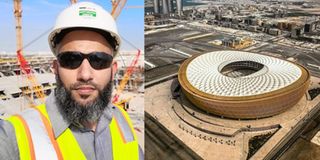Bakhresa: The engineer who delivered the Lusail Stadium in Qatar

What you need to know:
- The eight cutting-edge stadiums that host the games are the crown jewels of the infrastructure, which cost millions of dollars to build
Dar es Salaam. The World Cup 2022 is upon us. On November 20 (today), the first whistle will be blown to kick off the month-long global football bonanza in Doha as the host nation, Qatar, takes on Ecuador.
The infrastructure, which has cost millions of dollars, is quite a spectacle to behold, with the eight state-of-the-art stadiums that host the games at the top of the list.
A total of eight stadiums spread across five Qatari cities will host 32 teams in 64 matches during this year’s FIFA World Cup.
But as over a billion viewers in the television audience marvel at the beauty of the game and the infrastructural accomplishments that the Gulf state has managed to put together, one man will be watching the proceedings with unmatched contentment.
His story stands out for he was part of it all from the scratch.
Saeed Abdullah Bakhresa’s name crops up when the 80,000-capacity Lusail Stadium in Doha, the main stadium, is mentioned.
Engineer Bakhresa, one of many expatriate workers recruited to deliver what seemed like an impossible mission at one point, demonstrated his management and engineering skills as the Engineering Manager for the two and a half-year project, which is also the biggest stadium in Qatar, and where the final match will be played.
Last month, he was honoured for the completion and delivery of the Lusail Stadium in record time.
The Lusail Stadium reportedly cost $767 million (Sh1.7 trillion) to build and will host 10 matches throughout the World Cup, starting with Argentina versus Saudi Arabia on November 22.
“I joined the project in 2017, and we delivered quite on time. As the manager, I was tasked with planning and overseeing all the engineering works to deliver the required construction information and materials to the site teams as per specifications and the required schedule,” he says.
He adds: “I was leading and managing the engineering department to ensure we provide information to the site teams via drawings, materials, and 3D images to ensure we meet the construction schedule as planned.”
Speaking to The Citizen from his base in the UK, Bakhressa, who was until recently the project director of the real estate housing project Fumba Town Uptown Living in Zanzibar, says it was not an easy task to deliver a project of that magnitude on record time.
According to Bakhresa, a nephew of renowned businessman Said Salim Bakhresa, the stadium, which was built by a joint venture of the HBKCRCC (HBK Contracting and China Railway Construction Corporation), will live on in the memories of present and future generations.
“To me, it was an honour and privilege to be part of the team that delivered such an iconic landmark in Qatar that will be remembered by the whole world for a long time to come,” he says with a knowing smile. Despite the fact that the project was delivered to the taste of the contractors and the funders at certain times they had to take calculated risks.
“The design was lagging behind. So we had to take a calculated risk and commence construction before the design was approved, and probably this is where the schedule was won,” says Engineer Bakhresa. But, as the world descends on Qatar for the first winter World Cup, one question has remained unanswered: the issue of human rights violations against migrant workers in the Gulf state.
This, he says, was not what he saw during the construction of Lusail; in fact, he says the migrant workers were their driving force during the entire period of construction.
“To be honest, migrant workers were provided with the best facilities you can ever imagine, from accommodation to food to other facilities such as computers and games,” he says.
Engineer Bakhresa studied secondary education in Kenya before going to Hungary University for a bachelor’s degree and then to Manchester University for a master’s degree. His rich profile includes a stint in Saudi Arabia, where he worked on projects ranging from universities, football stadiums, arenas, and housing complexes with more than 10,000 housing units in 14 different sites across Saudi Arabia.
He has also worked in the United Kingdom for eight years as a young design engineer and is a chartered and registered structural engineer.
As for Lusail Stadium, upon completion of the World Cup on December 18, it will be transformed into a community space with schools, shops, cafés, sporting facilities, and health clinics.




